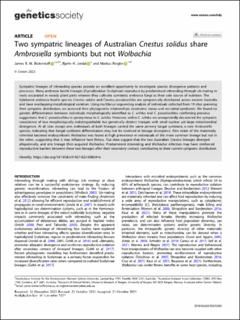| dc.contributor.author | Bickerstaff, James R. M. | |
| dc.contributor.author | Jordal, Bjarte Henry | |
| dc.contributor.author | Riegler, Markus | |
| dc.date.accessioned | 2024-04-17T12:23:29Z | |
| dc.date.available | 2024-04-17T12:23:29Z | |
| dc.date.created | 2023-11-29T12:53:24Z | |
| dc.date.issued | 2023 | |
| dc.identifier.issn | 0018-067X | |
| dc.identifier.uri | https://hdl.handle.net/11250/3127044 | |
| dc.description.abstract | Sympatric lineages of inbreeding species provide an excellent opportunity to investigate species divergence patterns and processes. Many ambrosia beetle lineages (Curculionidae: Scolytinae) reproduce by predominant inbreeding through sib mating in nests excavated in woody plant parts wherein they cultivate symbiotic ambrosia fungi as their sole source of nutrition. The Xyleborini ambrosia beetle species Cnestus solidus and Cnestus pseudosolidus are sympatrically distributed across eastern Australia and have overlapping morphological variation. Using multilocus sequencing analysis of individuals collected from 19 sites spanning their sympatric distribution, we assessed their phylogenetic relationships, taxonomic status and microbial symbionts. We found no genetic differentiation between individuals morphologically identified as C. solidus and C. pseudosolidus confirming previous suggestions that C. pseudosolidus is synonymous to C. solidus. However, within C. solidus we unexpectedly discovered the sympatric coexistence of two morphologically indistinguishable but genetically distinct lineages with small nuclear yet large mitochondrial divergence. At all sites except one, individuals of both lineages carried the same primary fungal symbiont, a new Ambrosiella species, indicating that fungal symbiont differentiation may not be involved in lineage divergence. One strain of the maternally inherited bacterial endosymbiont Wolbachia was found at high prevalence in individuals of the more common lineage but not in the other, suggesting that it may influence host fitness. Our data suggest that the two Australian Cnestus lineages diverged allopatrically, and one lineage then acquired Wolbachia. Predominant inbreeding and Wolbachia infection may have reinforced reproductive barriers between these two lineages after their secondary contact contributing to their current sympatric distribution. | en_US |
| dc.language.iso | eng | en_US |
| dc.publisher | Nature | en_US |
| dc.relation.uri | https://www.nature.com/articles/s41437-023-00659-w | |
| dc.rights | Navngivelse 4.0 Internasjonal | * |
| dc.rights.uri | http://creativecommons.org/licenses/by/4.0/deed.no | * |
| dc.title | Two sympatric lineages of Australian Cnestus solidus share Ambrosiella symbionts but not Wolbachia | en_US |
| dc.type | Journal article | en_US |
| dc.type | Peer reviewed | en_US |
| dc.description.version | publishedVersion | en_US |
| dc.rights.holder | Copyright 2023 Crown | en_US |
| cristin.ispublished | true | |
| cristin.fulltext | original | |
| cristin.qualitycode | 1 | |
| dc.identifier.doi | 10.1038/s41437-023-00659-w | |
| dc.identifier.cristin | 2205160 | |
| dc.source.journal | Heredity | en_US |
| dc.source.pagenumber | 43-53 | en_US |
| dc.identifier.citation | Heredity. 2023, 132, 43-53. | en_US |
| dc.source.volume | 132 | en_US |

